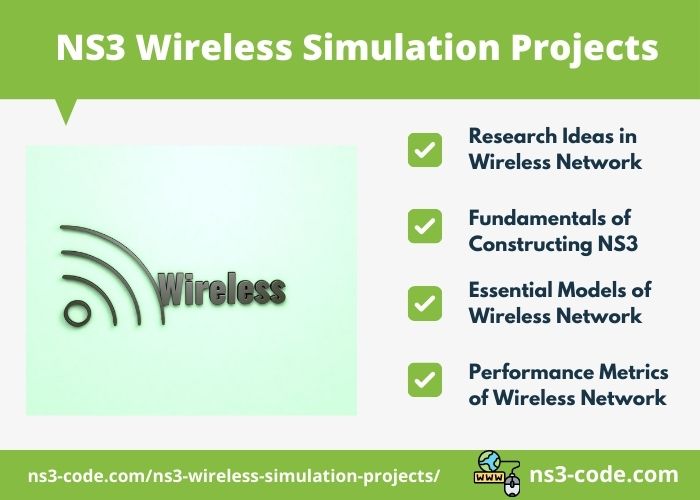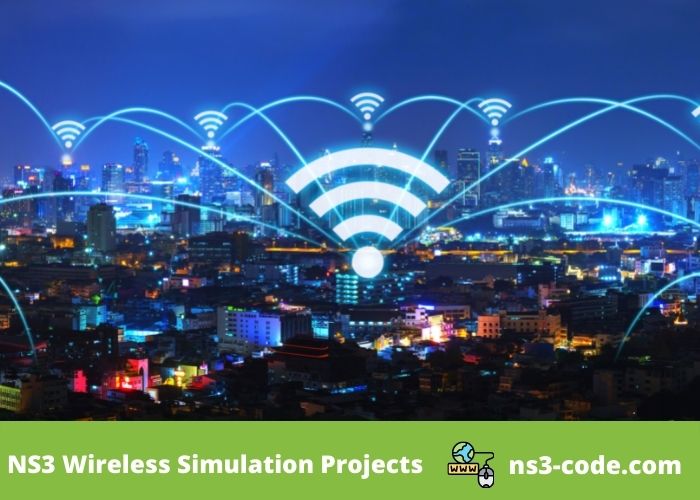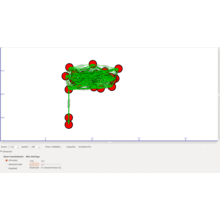In the beginning, the wireless network is destined for data transmission without physical communication links. Within a short span of time, wireless technologies have turn out to be the mastering technologies for digital communication. In specific, it is now focusing on heterogeneous wireless networks (HWN) which attains the consideration of the current research community. To create a low-cost network environment, everyone is moving towards the network simulator to design and simulate the network model based on custom needs. In addition, Ns3 Simulation provides reliability and accuracy in performance evaluation..
This page mainly focuses on NS3 Wireless Simulation Projects with technologies developments from a research perspective!!!
However, it is a forward-thinking technique; it has some limitations in real-world execution. Our resource team is proficient in both identifying and cracking technical issues of NS3 wireless simulation projects. If you are looking for the best guidance in solving your handpicked research problem, then we are ready to give appropriate solutions for your research challenges. For your awareness, here we have addressed the two primary encounters of wireless networks that the majority of scholars attempting to overcome.
Challenges of Wireless Network
- Mobility – Frequent random movements of the users / nodes
- Wireless – Transmission of data over wireless channel may leads to security threats
In network communication, the data are transmitted in the form of packets. That is, the data are divided into several small units called a packet. And, these packets are transmitted through different communication channels from source to destination. Here, the packet holds the following information.
Wireless Packet Information
- Packet – Create pointer for packet
- Expire Time -– Drop the packet once it expires
- Packet Type – Control or Information
Next, we can see the key characteristics of wireless links. These characteristics are more popular among research people where many of the research issues are framed from these characteristics. Our experts are ready to give you more information on other vital characteristics of Wireless Link.

Wireless Link Characteristics
- Multiple-Path Propagation
- When the radio signal reaching nearer to destination, radio signal get reflected from object ground and create time variations
- Low Signal Strength
- When the radio signal passes over the matters, it leads to loss of signal strength
- Inference Generated from Various Sources
- When more network devices shares the same frequency bands, it has the possibility of interference occurrences
From the theoretical perspective of NS3 wireless simulation Projects, most of the network simulators are working well in single-channel protocols for network performance assessment. At the same time, those simulators facing challenges in multiple radio/channel networks. Since it needs more adjustments to acquire expected results.
In general, the communication network study is based on both mathematical modeling and testing to attain the desired performance. In the past decades, analysis of mathematical function is a challenging issue, but now it is simplified through network simulation tools. It enables the developers to easily identify the real network performance and behavior. Also, it helps to study the working capabilities and efficiency of network protocols, techniques, algorithms, components, wireless topics for thesis etc. Overall, it is very useful in analyzing the protocol design, test network capacity, and performance in different scenarios.
Due to the great benefits of simulation, many simulators were already developed and more are under development. Particularly, NS-3 gains more attraction from the research community to develop their wireless simulation projects. Initially, NS-3 is the extended tool of NS-2. It inherits the key technologies of NS-2 and is enhanced with its own features. Below, we have given the difference between NS-2 and NS-3 simulators.
Difference between NS2 vs. NS3 simulator
NS2
- Lack of Goodput
- Unable to maintain dynamically
- Support only simulation of network model
- Inflexible to code with script language as TCL
- Recompilation is hard and time-consuming
- For network animation, utilize nam animator
- Be able to perform MANET simulation
- Difficult to obtain Power utilization
- MAC standard is fixed in default
NS3
- Availability of Goodput
- Able to maintain dynamically
- Provide DCE environ for emulation and simulation
- Flexible to code with script language as Python and C++
- Recompilation is ultra-speed through one command
- For network animation, utilize NetAnim and PyViz (python visualizer)
- Be able to perform NOC and MANET simulation
- Efficient to obtain Power utilization
- MAC standard can be defined in the case of necessity
What is NS-3?
NS-3 is the discrete event-based network simulation tool used to model and simulate communication systems. Also, it enables to modeling of different layers of OSI models starting from PHY to application. For efficient simulation, it incorporates different models for mobility, topologies, propagation, protocols, etc. Further, it also comprises different modules/components which are described below,
- Core – It is the main class for simulating and error correcting the models
- LTE NS3 module (to support LENA)
- Building module
- Spectrum module
- VoIP application module
- Antenna module
- WiFi module (to enhance, debug and validate WiFi model based on EXTREME testbed )
- Support routing protocols for backpressure and Prism header / Radiotap for Pcap traces
- Common Simulator – It is the packet class for scheduling
- Node and Mobility – It is the node class for tracking position of physical devices
- Routing, Internet Stack and Devices – It involves with network elements and protocols
- Helper – Application Programming Interface abstraction
Furthermore, our developers have given you the significance of the software program in NS-3. Moreover, the followings give you information on how we can employ the high-level design for a software program. Most importantly, our developers have sufficient practice in handling basic and advanced simulators to support you in all means.
Highlights of NS3
- Support C++ and Python scripts
- Support alignment of real-time interfaces which is applicable only in linux platform
- Provide modular architecture to design own protocols, models and modules
- Optimal Core Provisions of Simulator
- Enable smart pointer execution for automatic memory control
- Lower memory and Faster Functioning
- Copy-on-write packets
- Ability to create own object framework for tackling object composition issue
- Problems related to maintainability
- Testbeds for validation and regression testing
- Structured coding style
- Code evaluation method
- Give more importance on integration of realistic environment
- Mixing real code
- Passing actual packets
- Emulation mode
So far, we have discussed the fundamental details of NS3, now, we can see how the NS3 Wireless Simulation Projects are simulated/implemented. Here, we have given the steps to execute the wireless simulation model for your reference.
Procedure for NS3 Wireless Simulation Projects
- At first, set the configuration for the simulation
- Next, create the topology by deploying nodes in specified position with mobility models
- Then, install the netdevices on nodes and assign IP addresses for each devices
- After that, create transmission channel and stack along with techniques for communication and routing
- Next, monitor the current condition of all packet flows and perform data aggregation
- Then, gather eNBs or APs real state from the observation and track the different sources of the objects
- At last, install the application to run the simulation environment
We hope that you are clear in the procedure to develop a wireless simulation project in NS-3. Now we can see the software requirements of NS3 wireless simulation projects. Our developers are ready to clear your doubts in any of the NS-3 packages. So, if you have any technical queries then communicate with our team.
Requirements of NS-3 Package for Ubuntu
- Basic Needs
- g++, python-dev, gcc and NS3 python
- Statistical Database Capability
- sqlite3-dev, sqlite and sqlite3
- GTK-oriented Configuration
- libgtk2.0-dev and libgtk2.0-0
- Network Simulation Cradle
- bison and flex
- Xml-oriented Configuration
- libxml2-dev and libxml2
- GSL and Bug Fixing Provision
- libgsl0ldbl, gsl-bin, gdb valgrind and libgs10-dev
- Collecting packet traces which is in pcap file format
- wireshark and tcpdump
NS3 Simulator
- Doxygen – Reporting system (enable C, C+, and more)
- IDE – Eclipse CDT (Simple to read and change code)
Next, we can see in what way the NS3 wireless simulation projects are constructed using the NS 3 simulator. In this, we have specified the important facts on building “build” and “waf” files which are essential for network modeling and simulation.
Fundamentals for Constructing NS3 Wireless Simulation Projects
- Build
- Develop the build program as “build.py”
- Then, go to the location “ns-allinone/” through command
- Next, type the following command,
- ./build.py –enable-examples –enable-tests (examples and tests are disabled in default)
- Waf
- Develop the waf progam as “./waf”
- Then, optimize the build program and configure with your project
- For that, type the following commands,
- ./waf clean
- ./waf –d optimized –enable-example –enable-tests configure
- ./waf –d debug –enable-example –enable-tests configure
- ./waf configure
For the benefit of Ns-3 beginners, here we have the general structure of the program. The Ns-3 files are majorly codded in the following format only for simple network simulation. Further, the code structure will vary with extended functions based on the requirements of the projects. We are here to help with coding your project so contact us for the best project execution.
Structure of NS-3 Program
- Add “Header” files
- Add “Namespace”
- Disable or Enable “Logging”
- Construct the “Node”
- Form the “Topology” for Created Nodes
- Set the “Internet stack” and “Application”
- Run the “Simulation”
In addition to the program structure, the beginner should know the details of the fundamental models required for developing wireless networks. The below-specified models are very basic which have special functionalities to perform in wireless network simulation.
Essential Models for Wireless Networks
- Mobility Models (to track the moving node location)
- NetDevices Models (to install network interface card in node)
- Error Models (to deploy in every device)
- Propagation Models (to incorporate in channel-based objects and also it is does not dependent on any device)
So far, we have discussed every aspect of Wireless simulation projects using the NS-3 simulator for the welfares of scholars, academic students, engineers, and other researchers interested people. Essentially, we support you in both real-time and non-real-time wireless networking and communication systems at different scenarios, proofs, and degrees of reality. From us, you will also get more benefited through our detailed theoretical and experimental explanation of your handpicked problem. Further, you will also learn more in the following aspects.
What You’ll Learn in Executing NS3 Wireless Simulation Projects
- To create the program on ns-3 simulation tool
- To have user-friendly practice on handling simulator
- To grasp knowledge on wireless technologies and models used in simulations
- To implement techniques and protocols in the simulation environment
- To develop new algorithms / modules for network models (in both wireless and wired)
- To examine the outcomes generated at simulation
As mentioned earlier, network simulation is one of the best approaches to realize the behavior and performance of the network in advance. So, it is encouraged in several research fields such as wireless sensor networks, IoT, 5G NS3, Fog, etc. We ensure to support you in your interested field for designing and developing any sort of applications at any complex level. For your information, here we have given you list latest research ideas for NS3 wireless simulation Projects.
Research Topics on NS3 based Wireless Simulation
- Ultra-reliable Data Transmission in ITS
- Context-Aware Wireless Service Provisioning
- Satellite-based Backhaul and Remote Access
- Remote Patient-Care System in Wireless BAN
- Demand based Service Distribution in CDN
- Location-Aware Wireless Applications Implementation
- Urban Mobility Modeling for Dynamic Sensor Networks
- Integration of Satellite Network with Terrestrial Networks
- Designing of Prototype and Testbed for Wireless Applications
- System Architecture Modeling for Rural Data Transmission
- Emergency Message Dissemination in Wireless Network Security
- Governing Laws and Principles for Spectrum Controlling
- Secure Information Transmission in Real-time Wireless Applications
- Development of Mobile Communication in Vertical Industries
- Hybrid Technologies for Unlicensed and Licensed Spectrum Accessibility
- Human-Centric and Information-Centric Networks for Wireless Services
- Advance Beamforming techniques for Reconfigurable Intelligent Surfaces
- Secure Communication on Heterogeneous Networks (UAV, Terrestrial and Non-terrestrial Networks)
For any kind of NS3 Wireless Simulation Project, performance assessment is the most vital phase. Since it only determines whether the user requirements are satisfied or not. In specific, it evaluates the performance of the developed model from multiple aspects through several standard network parameters. Some of them are given below for your better understanding,

Performance Metrics for Wireless
- Average End-To-End Latency
- It signifies the normal duration to transfer data from source to destination
- Packet Delivery Ratio
- It calculates the ratio of total number of packets delivered successfully at destination
- Power Utilization
- It estimates the maximum power utilized by destination node for receiving packets
- Throughput
- It computes the ratio between total number of packets received at destination and simulation time
- Goodput
- It determines the total number of successful data delivered at destination in specific simulation duration
On the whole, we guarantee you that we provide you complete research and development service on your handpicked research area. If you have your own idea and seeking guidance for wireless simulator project development then approach us. We will surely support you to reach your research destination to implement NS3 Wireless Simulation Projects.

 Click Here to watch our latest output video using NS3 simulator
Click Here to watch our latest output video using NS3 simulator  Click Here to watch our latest projects screenshots using NS3 simulator
Click Here to watch our latest projects screenshots using NS3 simulator